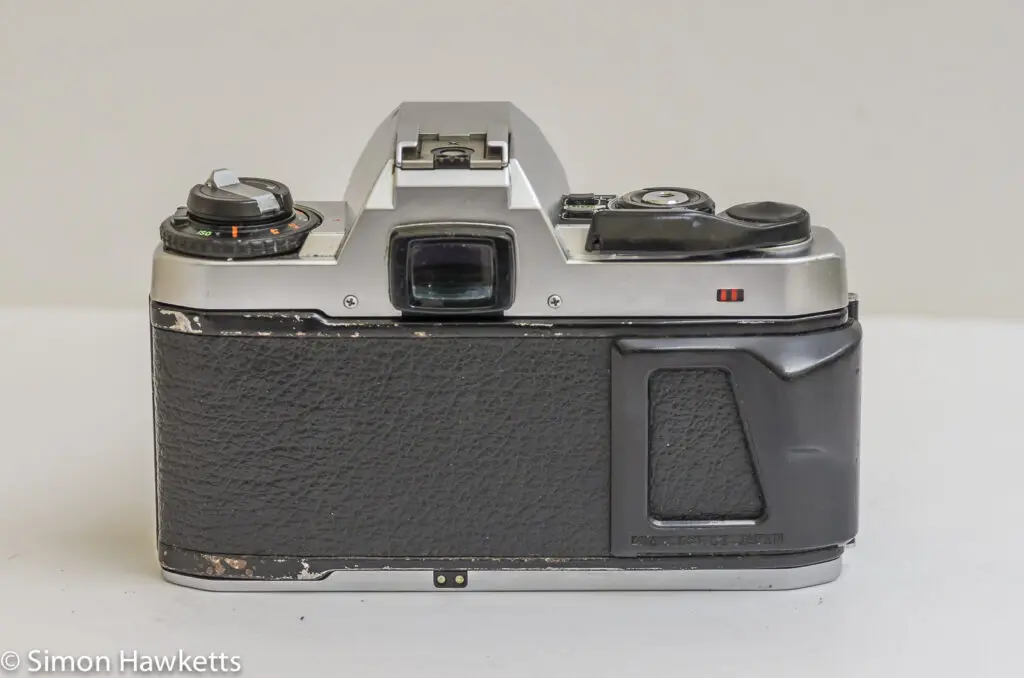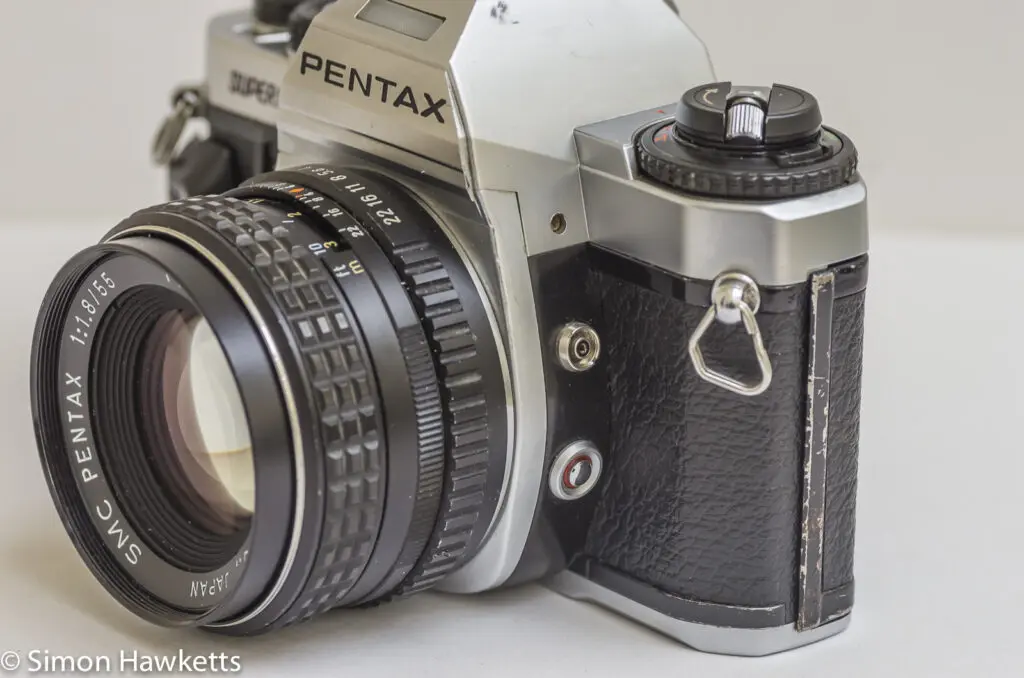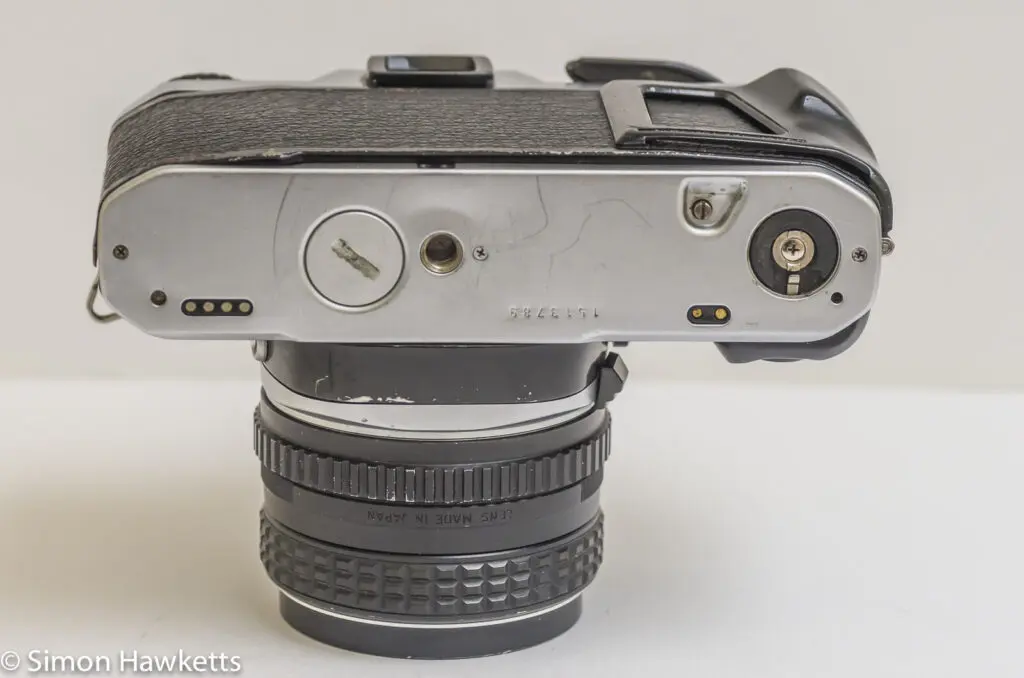Pentax Super Program / Super A review
This is a review of the Pentax Super Program (also known as the Super A) 35 mm manual focus camera.
Pentax Super Program Images













My Pentax Super Program / Super A Camera
I’ve been increasing my collection of Pentax cameras quite a lot over the last few months having added a P30T, a Spotmatic SP, a Spotmatic SP II, an S1, an SV and this camera, a Super Program. The good thing about Pentax is if you keep your eyes peeled, it’s possible to pick them up quite cheaply – I paid about £50 for all of those models combined.
I found this camera on eBay as a ‘sold as not working’ model and took a risk that it would probably be OK. I’ve wanted a Super A (which this camera is) since I got an ME Super a while ago, and although this camera looked a bit battered, I suspected by the description (‘numbers in viewfinder change as camera is moved’) that it was probably working. I like the feel and size of the ME Super, but my example has a problem with the film advance, and so wanted to get a Super Program as a ‘working replacement’.
The camera I bought was a body only unit, so for the pictures above I paired it with the A series lens from my P30, which would have been the same as the lens typically supplied with it when new.
When it arrived, I could see that it was a bit dirty and ‘well-loved’, but a quick test confirmed that the major parts of the camera are working without a problem. I think one of the things which may have confused the seller on eBay is the fact that there was a film in the camera, but it had torn off the reel and got stuck round the film advance post. This means the film advance was difficult to move and felt like it had seized.
I always check if there is a film in any camera I buy by turning the rewind crank to see if I feel any resistance. With this camera there was no resistance, so I opened the back and was surprised to see a canister in the camera. Then I saw the film on the film advance side and quickly closed the back again. I transferred the camera to a changing bag and removed the film, placing it in an empty re-loadable film canister until I can develop it. There is a good chance that some of the first shots which were tightly rolled up should still be OK and I find it really interesting to look at the pictures I find in old cameras.
Update: I developed the film and posted the pictures here, and I’ve also exposed and developed a film from the Program A which is a sister camera to the Super A – those pictures are here.
With the camera unloaded, the film advance was working correctly and everything else seemed functionally OK, but cosmetically there were some issues:
- A good coating of dust and grime over every surface
- A slight chip out of the film advance knob
- Some paint loss on the back panel
- A very dirty viewfinder
- The lettering of the words SuperProgram on the front missing paint
- The mirror damper was a gooey mess
- The self-timer switch was dirty and intermittent
The dirt and grime is a standard feature of most eBay sourced cameras, and I cleaned this one in the same way I normally clean cameras. First anything which can be removed I take off and give a good clean with an old tooth brush and soapy water, which on the Super Program was the front mounted grip. Then I use cotton buds slightly moistened and go over the camera to get as much off as I can. The camera cover I clean up with some Lens Cleaning solution from Boots, which I suspect is just soapy water as well, but it does a good job of cleaning the leather.
The mirror damper was easily replaced with some thin velvet ribbon, which I bought for that job a couple of years ago. I scrapped the old mess off and used some IPA on a cotton bud to clean the frame up ready for a new damper. Then, a small amount of strong double-sided tape secured the new pad in place.
For the front panel lettering, I used a very fine nib permanent marker pen and inked in the lettering, using an eyepiece to get a better view in close-up.
The viewfinder or rather the focus screen looked a more tricky job because I thought I’d need to remove the top of the camera to get to it, but as I was replacing the mirror damper I discovered two small screws which hold the focus screen tray in place. With these removed, I could lift the focus screen down enough to very carefully remove some of the bigger lumps of dirt with a cotton bud and use a blower to have a general clean up.
There were still some specs of dirt in the tracks of the Fresnel surface of the screen, but I couldn’t easily get those out, and the screen itself had some discolouration in the corners, but I thought I’d have to live with that. Some of the dirt in the viewfinder was actually on the mirror, which I very gently cleaned with a cotton bud soaked in IPA, and that also improved the situation somewhat.
I was going to leave it at that when I got an eBay notification of another ‘spares or repair’ Pentax Super Program camera which was going for £5. Since that looked in great condition but had a shutter problem, I decided to buy it and use it to improve the cosmetic condition of my camera.
When I received the new spares’ camera I was glad to see that the back panel was virtually spotless, the film advance lever undamaged and the focus screen immaculate. With those items swapped to my working camera, I had fixed all the issues other than the self-timer problem.
Pentax Super Program description
The Pentax Super Program / Super A was the top model in the Pentax ‘A’ series, which followed on from the M series in the early to mid 1980s. The body shape and size, however, is more reminiscent of the M range than others in the series like the A3 and A3000 and I would be amazed if it wasn’t built on the manual wind M series chassis rather than the motor wind A series.
In a similar way to the ME super, this is a small, reasonably light camera to carry around. In fact, it’s a bit better than the ME Super, because there is a removable grip fitted to the front of the camera which gives a better, well grip. Two versions of the camera were made, a black version and a Chrome version. Mine is the chrome, but personally I think the black version looks better.
Because it’s built after the influence of the Olympus OM series, it seems really small compared to both later motor drive models, and earlier models like the Spotmatic.
Control layout
The control layout of the Pentax Super Program is very similar to the ME Super, with a main mode dial surrounding the shutter release which controls the exposure modes of the camera, and a couple of buttons which adjust the shutter speed. The Mode dial has a small lock button which I find a bit fiddly to press in as I turn it, but it certainly stops the mode being set accidentally. I guess it’s a matter of personal taste, but personally, I don’t particularly like push button shutter speed control, but at least the buttons are conveniently placed.
Underneath the shutter button towards the back of the camera is a small LCD which shows the shutter speed selected and a P if the camera is in Program mode. On the opposite side of the top panel around the rewind crank is the ISO setting and exposure compensation. The ISO setting has a lock button which needs to be held down to alter the setting, which is easier to use than the lift and turn option which many cameras of this era had.
On the side of the lens barrel, there is a depth of field preview lever on the shutter release side, and a flash sync socket and viewfinder illumination button on the other side. All these controls are easy enough to find with the camera to your eye.
An optional motor drive unit was available for the Super Program, so the bottom of the camera has couplings to take that – on my version there is no cap over this, but I suspect this is just missing and would normally have been supplied.
Exposure modes.
The Pentax Super Program offers all the exposure modes most of us want from a camera, well a film camera anyway where exotic modes like Pentax’s shutter & aperture priority mode wouldn’t make sense.
The mode selection is carried out by a combination of the mode dial round the shutter release and the A position on the lens. The different options available are shown in the table below.
| Mode Dial setting | Lens Setting | Exposure Mode |
|---|---|---|
| Auto | P | Program Mode |
| Auto | Aperture value | Aperture Priority Mode |
| Manual | P | Shutter Priority Mode |
| Manual | Aperture value | Manual Mode |
Obviously, if the lens fitted is not an A series lens, the Program Mode and Shutter Priority mode options will not be available.
The other options available on the mode dial are a lock position which turns the camera off, a 1/125 position for flash and a B position for bulb.
The metering is centre weighted and there is no exposure lock facility, although there is a +/- 2 stop exposure compensation available on the dial round the rewind crank.
Viewfinder and display
As I said above, the viewfinder on my example of the camera was a bit grubby and cloudy, which detracts from the experience of using the camera, so I was particularly pleased that I could replace that component. Nicely clean, it is a great viewfinder to use because it’s quite big and with the f/1.7 lens I have fitted to mine it’s certainly bright.
The information display under the viewfinder is fairly minimalist, showing just the shutter speed on the left-hand side and another set of information on the right-hand side, however it’s enough to keep you informed. The other information shown in the right-hand display depends on the exposure mode selected. If it’s program mode or shutter priority mode the aperture is shown, if it’s aperture priority mode oddly enough it remains blank. In manual mode, the right-hand indicator shows the number of stops the exposure is under or over exposed. In any mode, if the exposure compensation is enabled, it is displayed to the side in the right-hand indicator.
The one bad point with the indicators is that they are difficult to see in bright sunlight. There is a button on the side of the lens barrel which turns on a light but, on my example at least, it didn’t offer much illumination.
In terms of focusing the camera has a horizontal split focusing screen which I find very useful in manual focus cameras, I’d just rather it was diagonal but there you go.
Overall impressions
The interesting thing about collecting cameras is that your favourite camera is a bit of a moving target and changes as you find new examples and new manufacturers. Well, I’m not new to Pentax, but the Super Program is my new favourite camera of the moment. It’s lightweight, has a wealth of exposure modes, has a good viewfinder and is also super attractive. I can’t wait to get it loaded with a reel of decent film and get out with it.
Pentax Super Program Specifications
- Pentax Super Program 35mm manual focus camera
- Otherwise known as Super A
- Won the European Camera of the Year award in 1983
- ISO range 6 to 3200
- Exposure Modes – Program mode, Aperture Priority, Shutter Priority & Manual Mode
- +/- 2 stops Exposure Compensation
- Shutter from 15s to 1/2000sec
- External motor drive available
- KA mount
- Flash sync socket and Hot Shoe
- Depth of Field Preview
- No mechanical operation – must have batteries fitted
- Sample Pictures here
- Body Ser No: 1513789
- Manual available on-line here
Discover more from Everything Vintage
Subscribe to get the latest posts sent to your email.








Good article.
I have owned many Pentax cameras, and I can say from experience that the Super A wasn’t the most successful film camera ever made – that was the Spotmatic, the camera that completely dominated the 1960s.
It wasn’t the best MF film camera ever made – that was the LX.
It wasn’t the most sophisticated film camera – that was the PZ1P.
But it was the NICEST camera Pentax ever made. It was deceptively simple but hugely flexible.
I foolishly gave mine to my wife, and when we split up, the camera went with her. But I bought a couple more on Ebay so even if I repeat my mistake with another wife, I will still have one left.